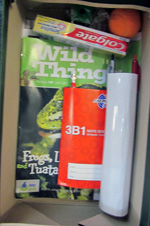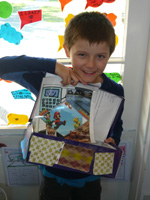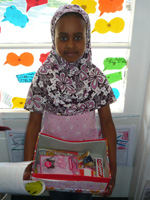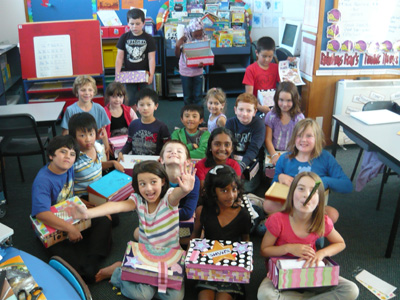by Sally Morch, MEd, Teacher, Greytown Primary School, Greytown, Wairarapa, New Zealand and Carmen Aldridge, Teacher, Christchurch East School, Christchurch, New Zealand
Once upon a time, a long time ago, in a land far, far away, the ground shook in a way not heard of before. Oh no! Not so long ago and not so far away, in fact the ground shook in a way that had often been heard of before.
In February 2011 the earthquake that shook Christchurch, New Zealand, was of a magnitude significantly less than that which had shaken the previous September but it caused considerably more damage. In fact the 6.5 earthquake that hit Christchurch at 1:00 p.m. on 22nd February resulted in 185 lives lost and many more people displaced from homes and businesses damaged or destroyed.
Children in schools were well taken care. Many of their schools were damaged. When they returned to school some children needed to use other sites for their classes.
Greytown Class Creates Boxes of Hope
During January 2012, when planning for the new year at school, teacher Sally Morch decided that the children in the class needed to look outside themselves and their immediate area. What better way to do this than to plan for an interaction between a class at a Christchurch school and her class in Greytown, New Zealand far away from the destruction?
While searching the Internet a "boxes of hope" unit of study was found that had been used by a teacher in the USA for her class to get to know their classmates.
This was adapted for use between the Greytown School class and a class in Christchurch. Initially a Christchurch New Zealand Reading Association (NZRA) delegate was contacted and she put Morch in touch with Christchurch East School. The principal kindly forwarded the email to a teacher of a similar year level.
Christchurch East School Room 4 teacher Carmen Aldridge e-mailed to sort things out between the classes so that by the end of the second week of Term 1 the Christchurch class had filled out a survey about their likes and dislikes.
Initially it was intended for the teacher to match up the children. Instead the class sat in a circle and talked about each survey and then they were asked to hand them around until someone felt that this person liked things they did or if they felt they liked the sound of a person. It was hard to believe but when the last survey was handed out, it went to someone of similar interests. In the end everybody had a survey.
That’s when the fun began! Each child in the class chose five special things about their buddy from the survey and made a Comic Life poster with the person’s name and illustrations of these items on it.
The students then wrote a bio-poem about themselves. They used a template so they all looked the same but with their own ideas. They wrote a letter to their Christchurch buddy to go in the box.

And then the fun began again! The children each chose a shoebox and spent several days decorating it with scrapbooking paper and cut out pictures until they were delight to behold. The boxes had been collected from the local Minx shoe store. Fortunately they were good solid boxes because they would be loved to death at both ends of the process, no doubt.
 Parents and families donated pens, rubbers, pads, notebooks, mini tennis balls, stickers, toothbrush and toothpaste, magazines, books and cars for the boys and pretty things for the girls. Soon the decorated shoeboxes were filled with goodies.
Parents and families donated pens, rubbers, pads, notebooks, mini tennis balls, stickers, toothbrush and toothpaste, magazines, books and cars for the boys and pretty things for the girls. Soon the decorated shoeboxes were filled with goodies.
Packaging them up was exciting. Using two very large cartons the shoeboxes were carefully stacked inside. With much manoeuvring getting them all in was accomplished, including a larger shoebox with extra goodies for the teacher.
Next step was to contact the courier. The cost for this was covered by a generous donation by one family business. Away the parcels went.
The Boxes Arrive
The teachers organised the two classes to Skype for the opening of the boxes of hope. On the last day of Term 1, big boxes arrived in Room 4 from Room 7 at Greytown School. The children in Room 4 were so excited. They were surprised at the amazing things in the boxes of hope and the generosity of the children in Room 7, their whānau, and the Greytown School community. The children now had lots of new things to do over the holidays.



Christchurch Responds with Thank You Boxes
At the beginning of Term 2, Room 4 students brainstormed what they could do for the children in Room 7, as they felt it was important to acknowledge their hard work and effort. This also fitted in with the Christchurch East School's schoolwide focus of "Giving Back to the Community." This theme came about after the year of earthquakes and it being timely to reminisce and think about all the schools, people, and businesses that had supported them during the past year. At the time they were learning about 3D shapes in geometry, so they decided to make boxes and call them "thank you Boxes."
They chose coloured card, decorated the outside, and cut, folded, and glued the boxes together. They chose candles to represent hope and thanks. They engraved the candles and filled the etched words with paint. Most of these just said "Thank You." They wrote a letter to our buddy to thank them, made bookmarks, and put donated items and individually chosen items in the boxes. The final task was closing the lids with stickers. The thank you boxes were packaged up and couriered off to Greytown School.

After the holidays at the beginning of Term 3, Aldridge heard from Mrs. Morch that they had received the parcel. The classes Skyped again and this time got to watch the Room 7 buddies open their boxes and chat to them. Both classes sang songs and talked to each other.
And so… to the end of the story. No, no not the end of the story at all as this is now going to be a continuing association between the two classes. Writing stories for each other and sharing via Skype. What an amazing, authentic context for writing.